
Merlot is a dark blue–colored wine grape variety, that is used as both a blending grape and for varietal wines. The name Merlot is thought to be a diminutive of merle, the French name for the blackbird, probably a reference to the color of the grape. Its softness and "fleshiness", combined with its earlier ripening, makes Merlot a popular grape for blending with the sterner, later-ripening Cabernet Sauvignon, which tends to be higher in tannin.
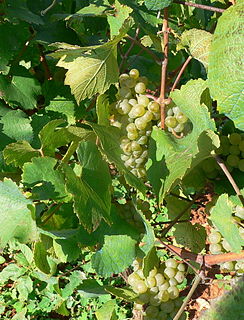
Malvasia is a group of wine grape varieties grown historically in the Mediterranean region, Balearic Islands, Canary Islands and the island of Madeira, but now grown in many of the winemaking regions of the world. In the past, the names Malvasia, Malvazia, and Malmsey have been used interchangeably for Malvasia-based wines; however, in modern oenology, "Malmsey" is now used almost exclusively for a sweet variety of Madeira wine made from the Malvasia grape. Grape varieties in this family include Malvasia bianca, Malvasia di Schierano, Malvasia negra, Malvasia nera, Malvasia nera di Brindisi, Malvasia di Candia aromatica, Malvasia odorosissima, and a number of other varieties.
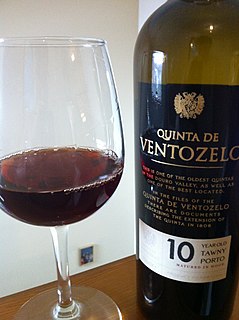
Port wine is a Portuguese fortified wine produced in the Douro Valley of northern Portugal. It is typically a sweet red wine, often served as a dessert wine, although it also comes in dry, semi-dry, and white varieties.

Grenache or Garnacha is one of the most widely planted red wine grape varieties in the world. It ripens late, so it needs hot, dry conditions such as those found in Spain, where the grape most likely originated. It is also grown in the Italian island of Sardinia, the south of France, Australia, and California's Monterey AVA and San Joaquin Valley.

Tempranillo is a black grape variety widely grown to make full-bodied red wines in its native Spain. Its name is the diminutive of the Spanish temprano ("early"), a reference to the fact that it ripens several weeks earlier than most Spanish red grapes. Tempranillo has been grown on the Iberian Peninsula since the time of Phoenician settlements. It is the main grape used in Rioja, and is often referred to as Spain's noble grape. The grape has been planted throughout the globe's wine regions.
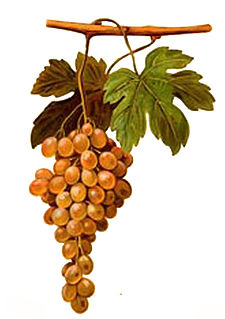
Pedro Ximénez is the name of a white Spanish wine grape variety grown in several Spanish wine regions but most notably in the denominación de origen (DO) of Montilla-Moriles. Here it is used to produce a varietal wine, an intensely sweet, dark, dessert sherry. It is made by drying the grapes under the hot sun, concentrating the sweetness, which are then used to create a thick, black liquid with a strong taste of raisins and molasses that is fortified and aged in solera.

Verdelho is a white wine grape grown throughout Portugal, though most associated with the island of Madeira, and also gives its name to one of the four main types of Madeira wine. At the turn of the 20th century it was the most widely planted white grape in Madeira.

Portuguese wine is the result of traditions introduced to the region by ancient civilizations, such as the Phoenicians, Carthaginians, Greeks, and mostly the Romans. Portugal started to export its wines to Rome during the Roman Empire. Modern exports developed with trade to England after the Methuen Treaty in 1703. From this commerce a wide variety of wines started to be grown in Portugal. And, in 1758, one of the first wine-producing regions of the world, the Região Demarcada do Douro was created under the orientation of Marquis of Pombal, in the Douro Valley. Portugal has two wine-producing regions protected by UNESCO as World Heritage: the Douro Valley Wine Region and Pico Island Wine Region. Portugal has a big variety of local kinds, producing a very wide variety of different wines with distinctive personality.

Douro is a Portuguese wine region centered on the Douro River in the Trás-os-Montes e Alto Douro region. It is sometimes referred to as the Alto Douro, as it is located some distance upstream from Porto, sheltered by mountain ranges from coastal influence. The region has Portugal's highest wine classification as a Denominação de Origem Controlada (DOC). While the region is associated primarily with Port wine production, the Douro produces just as much table wine as it does fortified wine. The non-fortified wines are typically referred to as "Douro wines".
South African wine has a history dating back to 1659, with the first bottle produced in Cape Town by its founder Jan van Riebeeck. Access to international markets led to new investment in the South African wine market. Production is concentrated around Cape Town, with major vineyard and production centres at Constantia, Paarl, Stellenbosch and Worcester. There are about 60 appellations within the Wine of Origin (WO) system, which was implemented in 1973 with a hierarchy of designated production regions, districts and wards. WO wines must only contain grapes from the specific area of origin. "Single vineyard" wines must come from a defined area of less than 5 hectares. An "Estate Wine" can come from adjacent farms if they are farmed together and wine is produced on site. A ward is an area with a distinctive soil type or climate and is roughly equivalent to a European appellation.
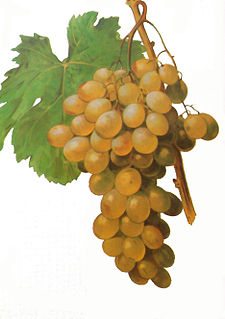
Muscat of Alexandria is a white wine grape that is a member of the Muscat family of Vitis vinifera. It is considered an "ancient vine", and wine experts believe it is one of the oldest genetically unmodified vines still in existence. The grape originated in North Africa, and the name is probably derived from its association with Ancient Egyptians who used the grape for wine making. It is also a table grape used for eating and raisins.
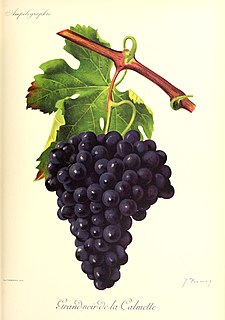
Grand Noir de la Calmette is a red teinturier grape variety that is a crossing of Petit Bouschet and Aramon noir created in 1855 by French grape breeder Henri Bouschet at his vineyard in Mauguio in the Hérault department. The grape was named after the breeding station Domaine de la Calmette. As a teinturier, Grand noir is often used to add color to wines that it is blended into but is paler than other choices such as Alicante Bouschet. The vine tends to bud late and has a high productivity but with some susceptibility to the viticultural hazard of powdery mildew.

Ribera del Guadiana is a Spanish Denominación de Origen Protegida (DOP) for wines located in the region of Extremadura (Spain). It extends over two provinces, Cáceres in the north and Badajoz in the south. It takes its name from the River Guadiana, which flows through the region from east to west.

Galician wine is Spanish wine made in the autonomous community of Galicia in the northwest corner of Spain. It includes wine made in the provinces of A Coruña, Ourense, Pontevedra and Lugo. Within Galicia are five Denominacións de Orixe (DO): Monterrei, Rías Baixas, Ribeira Sacra, Ribeiro and Valdeorras. In recent years, the region has seen a resurgence in its wine industry led by the international acclaim being received by the Rías Baixas region for its Albariño wines.
Moura is a Portuguese wine region centered on the town of Moura in the Alentejo wine region. The region was initially a separate Indicação de Proveniencia Regulamentada (IPR) region, but in 2003, it became one of eight subregions of the Alentejo DOC, which has the higher Denominação de Origem Controlada (DOC) status. Its name may still be indicated together with that of Alentejo, as Alentejo-Moura.
Portalegre is a Portuguese wine region centered on the Portalegre municipality in the Alentejo wine region. The region was initially an Indicação de Proveniencia Regulamentada (IPR) region, then elevated to Denominação de Origem Controlada (DOC) status. In 2003, it became one of eight subregions of the Alentejo DOC. Its name may still be indicated together with that of Alentejo, as Alentejo-Portalegre.
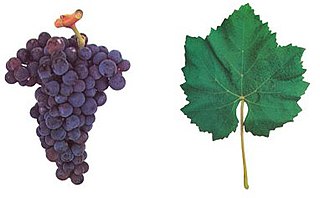
Castelão, in Portugal also known as Periquita and João de Santarém, is a red wine grape found primarily in the south coastal regions but is grown all over Portugal and is sometimes used in Port wine production. The name is derived from the Portuguese term for parakeet.

Treixadura or Trajadura is white Portuguese wine grape variety grown primarily in the Vinho Verde wine region of northeast Portugal and the Galician wine regions of Ribeiro and Rías Baixas in Spain where the variety is known as Treixadura. The grape is primarily a blending variety that adds body and light lemony aromatics to wines. It is most commonly blended with Loureiro and Alvarinho in Rías Baixas while in Ribeiro it is often blended with Torrontés and Lado.
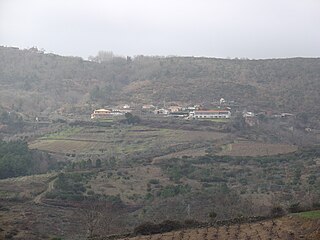
Tinta Carvalha is a red Portuguese wine grape variety that is widely planted throughout Portugal, most notably in the Trás-os-Montes e Alto Douro Province, due to its easy maintenance and high yield potential. It is primarily a blending grape that on its own tends to produce light bodied, nondescript wines. It is an approved grape variety used in Port wine production as well as the non-fortified wines of the Chaves and Valpaços wine region.

Hebén is a very rare white grape variety grown for wine and table grapes in Spain. It is an ancient variety found to have originated as a table grape in North Africa as Gibi. It is the parent variety of a large number of grapes grown in the Iberian Peninsula and the wider Mediterranean. It has paired with Alfrocheiro to produce the rare Portuguese varieties Trincadeira das pratas, Tinta grossa, Castelão branco, and Malvasia fina, as well as the Spanish Allarén. With Muscat of Alexandria it has produced Moscatel nunes/Nuno gomes in Portugal and Moscatel de Angüés in Spain. In Spain, it has a parent relationship with some very widely grown varieties: Airén, Cayetana, Viura, Xarel·lo, and Pedro Ximénez. In total, around 60 offspring varieties have been identified. Its sparse bunches are an attribute that can be seen some in children varieties such as Pedro Ximénez and Xarello. It produces solely female flowers, unlike the majority of self-pollinating vinifera varieties grown for wine today.

















